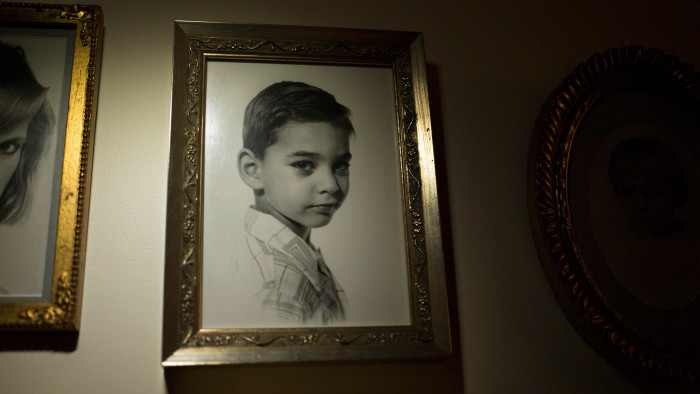Report from the Interior, by Paul Auster

Roula Khalaf, Editor of the FT, selects her favourite stories in this weekly newsletter.
Report from the Interior, by Paul Auster, Faber, RRP£18.99 / Henry Holt & Co, RRP$27, 341 pages
Paul Auster, with his quizzical gaze and Kafka-like looks, is a European spirit in American letters. Like his idol Samuel Beckett (whom he met in Paris in the 1970s), Auster elaborates his fiction with quasi-existential conundrums and finds a lugubrious comedy in human failings. Not everyone has been impressed. His work is of great formal brilliance, say his detractors, but of negligible import.
Typically for Auster, Report from the Interior is not a straightforward read. A companion to his earlier memoir, Winter Journal (2012), it continues his autobiographical exploration of 1950s suburban New Jersey and the difficulties he experienced in growing up there. Auster writes movingly of his parents’ Polish-Jewish ancestry and his own sense of alienation from mainstream Protestant culture in America: “There were no cowboys called Bernstein or Schwartz, no private eyes called Greenberg or Cohen, and no presidential candidates whose parents had emigrated from the shtetls of eastern Poland and Russia.”
The book’s second half, which covers Columbia University and the Vietnam war, includes self-consciously literary letters from Auster to his first wife, the fiction writer Lydia Davis, which are not always interesting to read. The book’s more personal digressions fail to draw the reader in at times.
Adventurously, Auster chose to narrate Winter Journal in the second person, and Report from the Interior continues in the same style (“Who were you, little man?”). This distancing device may appear pretentious but, on the whole, it works. In his trademark plain prose, Auster explores his parents’ unhappy marriage and his own debilitating shyness in adult company. Auster’s was a childhood marked by bouts of nocturnal bed-wetting, “a curse you carried round with you far longer than was seemly for a boy your age”, and he writes of the “humiliation” of having a rubber sheet on his bed.
He also had a fastidious aversion to certain foodstuffs, felt sick just to look at them, and “each time you failed to finish off what had been served to you, you would think about the boys and girls of India and feel riven with guilt”. To write so candidly of one’s growing-up takes some courage; beneath the polite surface of the prose, the granite shows through painfully.
Report from the Interior is, above all, a chronicle of postwar America, with its anti-Soviet antagonisms, baseball culture and B-movie science fiction industry. In a 25-page bravura performance, Auster chronicles in mesmeric detail the effect The Incredible Shrinking Man had on him as a 10-year-old in 1957. The shock of the film was almost “theological” in its intensity: Auster was left reeling at the thought of man’s potential insignificance in the universe. No less electrifying for him was the 1932 Warner Brothers production I Am a Fugitive from a Chain Gang, which he saw on his parents’ television set one night. Set in a punitive Dixieland backwater, the movie was impossible to watch without thinking of second world war death camps, says Auster, whose own Jewishness became more apparent to him as the 1950s gave way to the 1960s.
Predictably, Auster’s childhood was brightened by the Boy’s Own staples of Sir Arthur Conan Doyle and Robert Louis Stevenson. Although he grew up in a house with “few books”, Auster was given a set of Stevenson’s works by his beloved grandmother for his eighth birthday. And just as Stevenson had liked to “go Crusoing” in East Lothian at night with a lantern, so the boy Auster liked to make a “glowing jar” out of captured fireflies in Newark. The tense action across loch and moor that Henry James so admired in Kidnapped left its mark on Auster, whose “juvenile efforts at scribbling” were written under Stevenson’s sway. Conan Doyle’s subtle, hawk-eyed Sherlock Holmes, complete with pipe, Stradivarius and magnifying glass, filled Auster’s “solitary hours” as a child and became a model for him of fierce “intellectual probity”. Something of Doyle’s scientist-sleuth is detectable in Auster’s celebrated New York Trilogy (1985-86) of novels, which fuse the hermetic sparsities of Beckett’s Molloy with a Sherlockian element of detective story.
Auster’s exploration of his childhood mind, while certainly brave, is not always successful. In the name of literary truth, he includes the most humdrum of details. The impact of rock and roll on the teenage Auster – Chuck Berry, Buddy Holly, the Everly Brothers – is standard 1950s American fare. So, too, is the fact that Auster loved the TV character Felix the Cat. This obsessive recreation of the past can at times verge on the narcissistic. Do we really need to know all this?
The inclusion of the letters to Davis was probably ill-advised. While these give a vivid enough picture of mid-1960s Paris, where Auster briefly went to live as a Columbia University student, they contain callow and often embarrassing revelations. (“I sometimes shudder to realize that I am unfit to be loved by anyone.”)
The book’s long drawn-out epistolary sections have the feel of a filing cabinet: Auster sifted through more than 500 pages of his personal correspondence deposited in the New York Public Library in order to write them. Other parts of Report from the Interior, fortunately, are a delight; the punctilious descriptions of mid-century suburban America are both funny and oddly affecting.
Ian Thomson is author of ‘Primo Levi: A Life’ (Vintage)
Comments